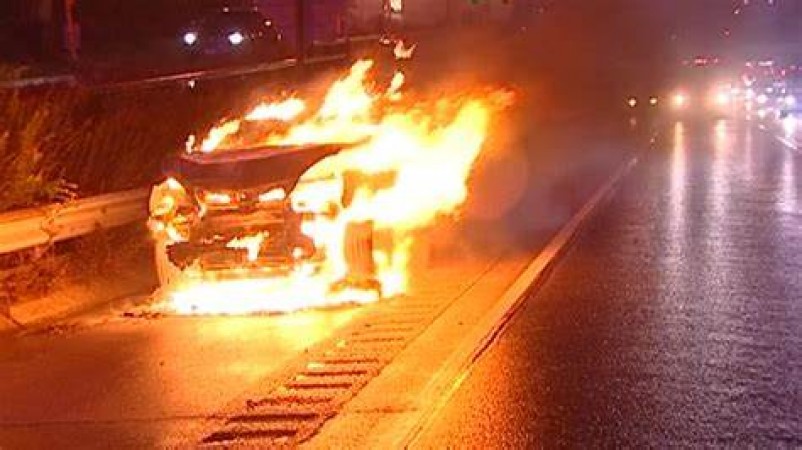
Imagine driving down the road on a sunny day when suddenly, you notice smoke billowing from your car's engine. It's a terrifying situation that can happen to anyone. In such a critical moment, knowing what to do can make all the difference between a minor incident and a catastrophic one. This article will guide you through the essential steps to take if your car catches fire, ensuring your safety and minimizing potential losses.
When faced with a car fire, the first and most crucial thing to do is remain calm. Panic can cloud your judgment and lead to dangerous decisions. Take a deep breath and focus on these immediate actions.
Ensuring Your Safety
As soon as you notice smoke or flames, gently steer your car to the side of the road, away from traffic. Use your turn signals to indicate your intentions to other drivers. Parking your car away from buildings or other flammable objects is essential to prevent the fire from spreading.
Preventing Fuel Supply
Quickly turn off the engine and remove the key from the ignition. This step will cut off the fuel supply to the fire, reducing the risk of an explosion.
Your Safety First
Leave the car immediately, ensuring all passengers do the same. Do not attempt to retrieve personal belongings, as your safety is the top priority. Move at least 100 feet away from the vehicle to avoid exposure to toxic fumes and potential explosions.
Dial 911
Once you are at a safe distance, call 911 or the emergency services number in your region to report the fire. Provide your location and the details of the incident, including the fact that your car is on fire.
If Safe and Confident
If you have a fire extinguisher in your car and you are confident in using it, attempt to put out the fire. Stand at a safe distance and aim the extinguisher at the base of the flames, using a sweeping motion.
Risk of Fuel Ignition
Under no circumstances should you open the car's hood if you suspect a fire in the engine compartment. Opening the hood can introduce oxygen and fuel, potentially causing a dangerous explosion.
Protecting Others on the Road
Use hazard lights, flares, or reflective triangles to warn other motorists of the fire. This will help prevent accidents and keep people at a safe distance from the incident.
Professional Intervention
After taking the initial steps, remain at a safe distance from your vehicle and wait for the arrival of the fire department. They are equipped to handle car fires safely and efficiently.
For Insurance Purposes
If it's safe to do so, take photos or videos of the fire and the damage to your vehicle. This documentation can be valuable when dealing with insurance claims.
Post-Fire Inspection
Even if the fire appears to be extinguished, do not attempt to restart or drive the car. It may have suffered internal damage that could lead to further complications.
Begin the Claims Process
As soon as possible, contact your insurance company to report the incident and start the claims process. Provide them with all the necessary information and documentation.
Transporting the Vehicle
Coordinate with a tow truck service to safely remove your damaged car from the scene. Inform them of the fire incident so they can take appropriate precautions.
Check for Injuries
If you or any passengers experience smoke inhalation or injuries, seek immediate medical attention. Even minor symptoms should not be ignored.
Investigation
Work with fire investigators to determine the cause of the car fire. This information may be crucial for insurance purposes and preventing future incidents.
Addressing the Aftermath
After the fire is out and the investigation is complete, you'll need to address the cleanup and recovery process, which may involve working with an auto repair shop.
Reducing the Risk
Learn from the incident and take preventive measures to reduce the risk of future car fires, such as regular vehicle maintenance and inspections.
Know Your Rights
Understand your legal rights and responsibilities when dealing with insurance claims and any potential liability related to the fire.
Coping with Trauma
Seek emotional support if needed, as a car fire can be a traumatic experience. Reach out to friends, family, or counseling services for assistance.
Learning and Preparedness
Stay informed about car safety and emergency procedures to ensure you are prepared for unexpected situations on the road. In conclusion, knowing how to respond when your car catches fire is crucial for your safety and the safety of others on the road. By following these steps, you can minimize potential losses and ensure a swift and coordinated response in a high-stress situation.
Dalai Lama Advocates 'Middle Way' for Tibet Amid Devotee Gathering
Overseas Miners Eye Lithium Reserves in Upcoming Jammu and Kashmir Auction
New Volkswagen Tiguan revealed, know how much has changed compared to before